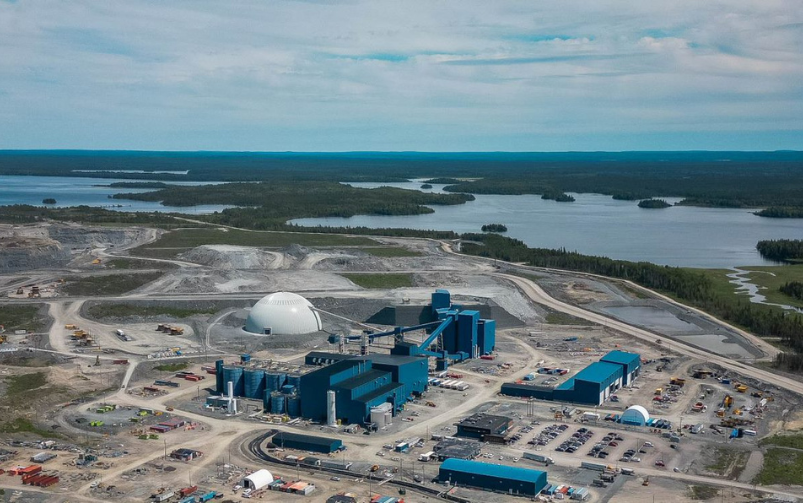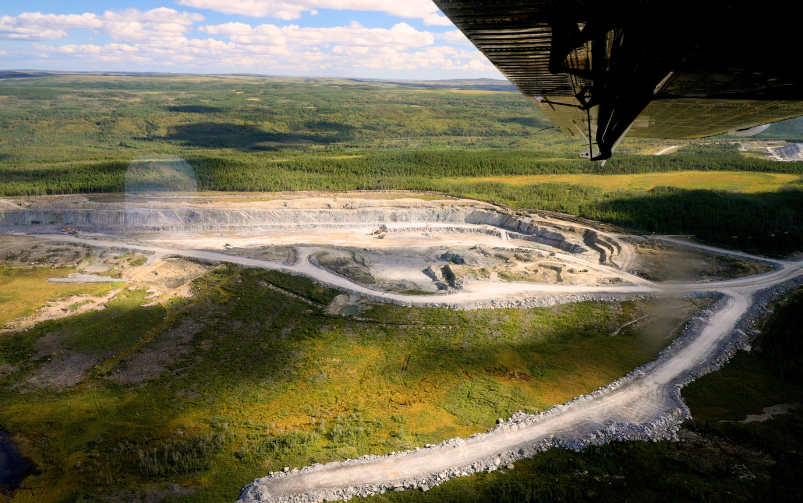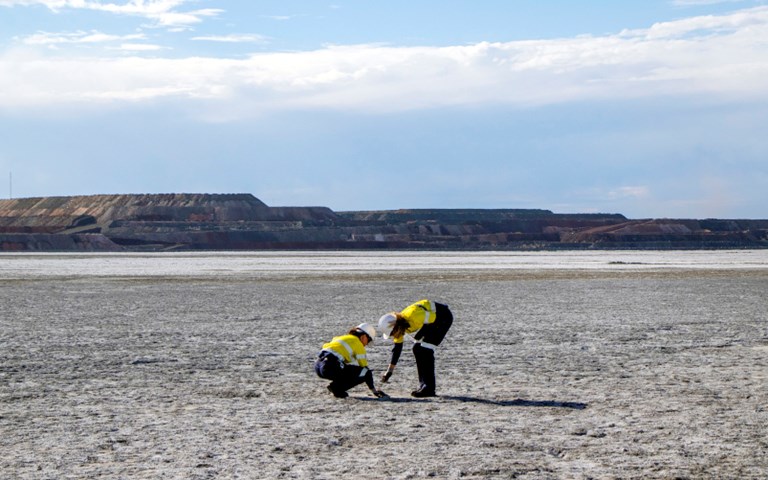Arca’s R&D scientists, Anne-Martine Doucet and Frances Jones, sampling the surface of the tailings storage facility at BHP’s Nickel West mine at Mount Keith in Kalgoorlie, Western Australia. Courtesy of Arca Climate Technologies Inc.
At BHP’s Nickel West mine at Mount Keith in Kalgoorlie, Western Australia, autonomous rovers and surface manipulation machines are being put to work on an area of its tailings dam, churning up material and speeding up the process of carbon mineralization.
The proprietary technology was developed by Vancouver-headquartered Arca Climate Technologies Inc., which announced in a press release on Nov. 29, 2023, that it is piloting its air-to-rock carbon mineralization process for the next 18 months at Nickel West with the support of a $1.25 million grant from the B.C. Centre for Innovation and Clean Energy (CICE).
“With CICE’s support, Arca is in a great position to accelerate large-scale implementation,” said Todd Sayers, CICE’s chief operating officer, in the press release.
Carbon mineralization is a natural process that occurs when certain rocks or minerals are weathered and react with CO2 in the atmosphere, storing it in a stable form as solid carbonates. According to BHP, the Nickel West tailings dam—which is one of Australia’s biggest tailings dams—already stores approximately 40,000 tonnes of CO2 from the atmosphere each year through this process, which it said is the equivalent of offsetting the CO2 emissions of 15,000 vehicles.
By accelerating this passive process, the site could potentially remove millions of tonnes of CO2 from the atmosphere and become a massive carbon sink. It is an attractive proposition, not just for mining companies looking to decarbonize their operations, but also for companies further down the supply chain. “We’re hearing directly from producers of critical metals that their customers are looking for low-carbon or zero-carbon metals,” said Paul Needham, the CEO of Arca, in an interview with CIM Magazine. Tesla, for example, has been actively seeking out low-carbon nickel for its batteries, which led the EV giant to sign nickel supply deals with BHP and Vale in the last few years.
Needham said the company has established a control plot at Nickel West, along with a small area where it will be transforming the tailings and capturing and storing carbon using magnesium-rich ultramafic rock.
“We’re using electromagnetic radiation microwaves to selectively target components within the serpentine mineral structure, disrupting that mineral structure and liberating the magnesium,” Needham said. “The material becomes very, very reactive to CO2.”
Needham said that this is the first pilot of its kind in the world, as the testing of the carbon mineralization technology is taking place at an active mine site.
“In that area where we treat [tailings], we’ll be churning the material,” he said. “We’ll be controlling factors like moisture level, alkalinity and surface area, and putting into practice what we’ve done on pilot sites, so we’re integrating a number of technologies that we’ve tested on other sites elsewhere in the world. This is the first time that everything’s coming together on an active mine site. And this is a very large nickel mine—the tailings storage facilities are about 16 square kilometres [in surface area]. They’ve been mining there for more than 25 years. That one site has the potential to store multiple megatonnes of carbon dioxide.”
Needham said that by using a dynamic closed chamber to measure the concentration of CO2 in the air in the sample plot of the tailings dam, Arca has found that its technology can restore the air from 420 parts per million (ppm) of CO2 to 250 ppm of CO2 in a period of five minutes. According to an article published on the Massachusetts Institute of Technology (MIT) climate portal, the ideal range of CO2 in the atmosphere to support human life is about 280 ppm to 350 ppm, which is roughly what the global levels were before the industrial revolution. Today, global levels are at about 420 ppm, according to a November 2023 measurement taken at the Mauna Loa Observatory.
“What’s happening is the CO2 is getting dissolved into the water that’s present, then mineralizing by binding with magnesium ions to form new magnesium carbonate minerals,” he said. “When you think about the speed of that… It’s something like 50 tonnes of CO2 per hectare per year, which compares very well to forests. It’s very surprising that these mine tailings, with the right minerals, are capturing carbon dioxide faster than a forest.”
The company is not currently disclosing how much carbon the 18-month pilot project is expected to sequester and said it will announce the results after the data has been verified by a third-party.
Arca is exploring pilot opportunities at other mine sites in Australia and Canada that could happen before the end of this year.
Needham said that throughout Arca’s experiments, it has found that the carbon mineralization process has helped make the tailings more stable in some contexts, an unexpected benefit it plans to further examine as it deploys its next pilot projects.
“I really think there’s an opportunity to create more stable, more safe mine tailings, while also capturing value or creating value by capturing CO2 from the atmosphere,” he added. “I think these tailings aren’t merely a liability. There’s also a win-win scenario here.”




